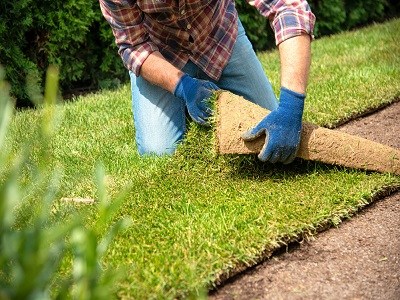
Laying sod to create a new lawn is not the same as sowing seed. There are pros and disadvantages to this method. Laying sod can give you a lawn in a matter of minutes. However, sod is more expensive than seed. Don’t let the immediate results of laying sod fool you. There are just as many preparations involved in sowing seed. Proper lawn care should start right after you finish laying it.
There are times when homeowners feel they need new grass and it is urgently needed (e.g., to sell a house). In these cases, sod may be the best option. The only problem is choosing the right type of sod.
How to choose the best sod for your lawn
There are many factors that go into deciding the best type of sod grass for you. These include where you live, what you want to use your lawn for, and your tolerance of challenging conditions.
Ryegrass (Lolium perenne)
There are many types of ryegrass. Lolium perenne is a perennial ryegrass that you’ll need to consider when choosing ryegrass seed.
The downsides of cool-season grass include a need for more fertilizer and water, as well as a less attractive appearance. This cool-season grass forms clumps rather than spreading through stolons and rhizomes like other grass types. This characteristic can make your lawn look patchy, instead of smooth.
Kentucky Bluegrass (Poa pratensis)
Kentucky bluegrass is a cool-season variety that can withstand both human and dog traffic as well as urine and light shade. It requires more fertilization than other grass types. It is one of the hardiest grasses, and it can be found in states farther north. It spreads by rhizomes, creating a dense mat of attractive color. You may need professional fertilizing services to better take care of this grass variant.
Tall Fescue Grass (Festuca arundinacea)
This cool-season grass is easy to identify. The topsides of this grass are shiny and have wide blades. It spreads mainly by seed distribution, rather than creeping. People looking for a uniform lawn will find it awkward because of its clumping, upright growth habits. It is resistant to urine, dog traffic, and human foot traffic.
Fine Fescue (Festuca spp.)
Fine fescue is shorter than tall fescue. This gives it a fine texture, and an appearance that is superior to its taller cousin. There are many types of fine fescue. All are cool-season grasses. Sometimes you’ll find a mix of chewings and two types of creeping red, sheep fescue or hard fescue.
Fine fescue is most prized for its tolerance of shade. It is drought-tolerant, salt-tolerant, and suitable for seacoast communities. It is a great low-maintenance grass that doesn’t require much fertilization. It is not able to withstand heavy traffic from dogs and people.
St. Augustine Grass (Stenotaphrum secundatum)
This warm-season grass is creepy and has a low habit of spreading. It can form dense mats. It spreads by stolons. Its grass blades are flat and wide. St. Augustine grass can withstand salt, making it a great choice for those who live near the ocean. St. Augustine grass is also a great choice for Southerners who have shady areas in their yard. It is one of the warm-season grasses that are most shade-tolerant.
St. Augustine grass has another advantage: you don’t need to mow as often, which is something you will appreciate if your preference is low maintenance. However, it is not without maintenance. It thrives with proper irrigation and fertilization.
Zoysia grass (Zoysia japonica)
Zoysia grass spreads through stolons, rhizomes, and leaves to create a dense mat. However, it can spread too freely and invade adjacent flower beds. You will need to remove the excess thatch to maintain a healthy lawn. This warm-season grass is tolerant to human traffic, dog traffic, and urine.
Centipede Grass (Eremochloa ophiuroides)
This warm-season grass is not able to withstand human foot traffic, dog walking, or urine. It can tolerate acidic soil. It doesn’t require much fertilization or irrigation. In fact, its greatest asset is its low maintenance. It spreads by stolons and forms a thick mat that keeps the weeds down. This also helps to reduce lawn maintenance.
Bermuda Grass (Cynodon dactylon)
The vigor of this warm-season grass is due to its spread by stolons or rhizomes. However, vigor can come with a cost. Bermuda grass is tolerant of human traffic, dogs, and urine. It also has excellent drought tolerance and salt tolerance. It is also difficult to control and requires frequent mowing. It is advised to get professional lawn care services if you have Bermuda grass in your lawn for better management.
Bahia Grass (Paspalum notatum)
This warm-season grass works well in soils with low fertility. This allows you to save money on fertilizers. Bahia grass is also a good choice for acidic soils where you don’t need to increase the pH. Bahia grass can withstand drought. It is moderately resistant to foot traffic, dog traffic, and urine. It spreads via stolons but isn’t as aggressive as other stoloniferous grasses. This makes it easier to keep out of your garden.
Call Conway Lawn Care Service for professional landscaping and lawn care services.
Like our Facebook page for more great info about lawn care services.
Conway Lawn Care Service
Conway, SC 29526
843-353-2259
http://conwaylawncareservices.com/
No comments:
Post a Comment